Ryan Liu
LLM Social Simulations Are a Promising Research Method
Apr 03, 2025Abstract:Accurate and verifiable large language model (LLM) simulations of human research subjects promise an accessible data source for understanding human behavior and training new AI systems. However, results to date have been limited, and few social scientists have adopted these methods. In this position paper, we argue that the promise of LLM social simulations can be achieved by addressing five tractable challenges. We ground our argument in a literature survey of empirical comparisons between LLMs and human research subjects, commentaries on the topic, and related work. We identify promising directions with prompting, fine-tuning, and complementary methods. We believe that LLM social simulations can already be used for exploratory research, such as pilot experiments for psychology, economics, sociology, and marketing. More widespread use may soon be possible with rapidly advancing LLM capabilities, and researchers should prioritize developing conceptual models and evaluations that can be iteratively deployed and refined at pace with ongoing AI advances.
Using the Tools of Cognitive Science to Understand Large Language Models at Different Levels of Analysis
Mar 17, 2025Abstract:Modern artificial intelligence systems, such as large language models, are increasingly powerful but also increasingly hard to understand. Recognizing this problem as analogous to the historical difficulties in understanding the human mind, we argue that methods developed in cognitive science can be useful for understanding large language models. We propose a framework for applying these methods based on Marr's three levels of analysis. By revisiting established cognitive science techniques relevant to each level and illustrating their potential to yield insights into the behavior and internal organization of large language models, we aim to provide a toolkit for making sense of these new kinds of minds.
On Benchmarking Human-Like Intelligence in Machines
Feb 27, 2025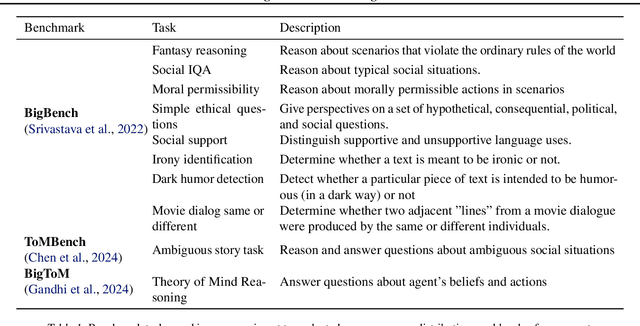
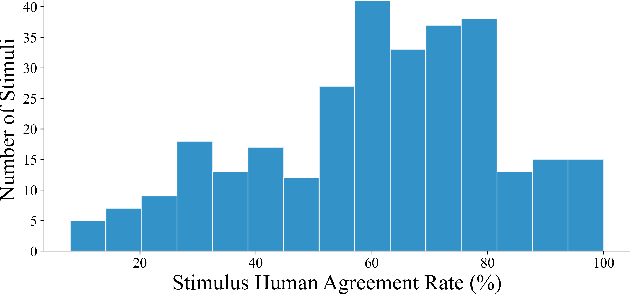
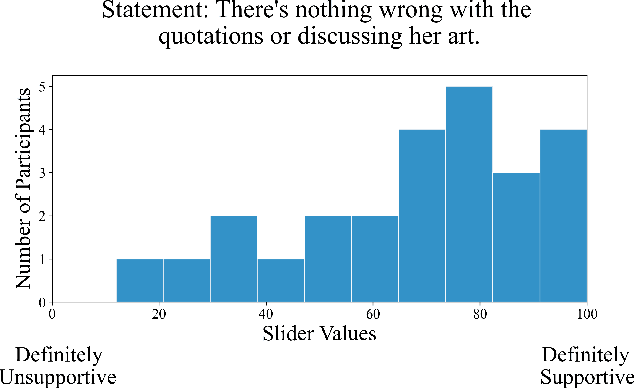
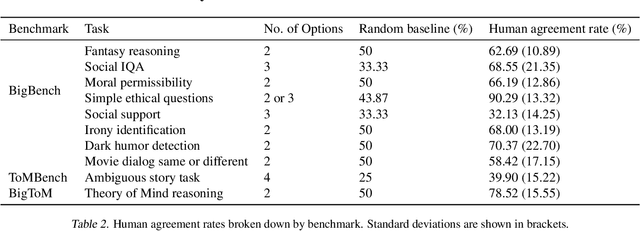
Abstract:Recent benchmark studies have claimed that AI has approached or even surpassed human-level performances on various cognitive tasks. However, this position paper argues that current AI evaluation paradigms are insufficient for assessing human-like cognitive capabilities. We identify a set of key shortcomings: a lack of human-validated labels, inadequate representation of human response variability and uncertainty, and reliance on simplified and ecologically-invalid tasks. We support our claims by conducting a human evaluation study on ten existing AI benchmarks, suggesting significant biases and flaws in task and label designs. To address these limitations, we propose five concrete recommendations for developing future benchmarks that will enable more rigorous and meaningful evaluations of human-like cognitive capacities in AI with various implications for such AI applications.
RLHS: Mitigating Misalignment in RLHF with Hindsight Simulation
Jan 15, 2025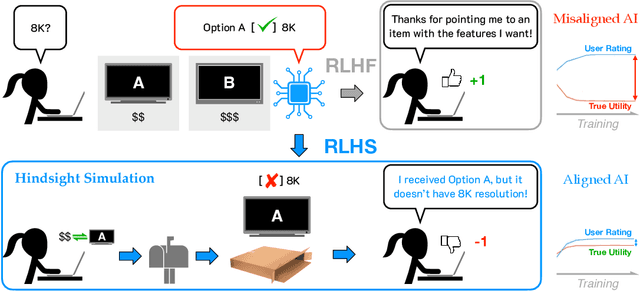



Abstract:Generative AI systems like foundation models (FMs) must align well with human values to ensure their behavior is helpful and trustworthy. While Reinforcement Learning from Human Feedback (RLHF) has shown promise for optimizing model performance using human judgments, existing RLHF pipelines predominantly rely on immediate feedback, which can fail to accurately reflect the downstream impact of an interaction on users' utility. We demonstrate that feedback based on evaluators' foresight estimates of downstream consequences systematically induces Goodhart's Law dynamics, incentivizing misaligned behaviors like sycophancy and deception and ultimately degrading user outcomes. To alleviate this, we propose decoupling evaluation from prediction by refocusing RLHF on hindsight feedback. Our theoretical analysis reveals that conditioning evaluator feedback on downstream observations mitigates misalignment and improves expected human utility, even when these observations are simulated by the AI system itself. To leverage this insight in a practical alignment algorithm, we introduce Reinforcement Learning from Hindsight Simulation (RLHS), which first simulates plausible consequences and then elicits feedback to assess what behaviors were genuinely beneficial in hindsight. We apply RLHS to two widely-employed online and offline preference optimization methods -- Proximal Policy Optimization (PPO) and Direct Preference Optimization (DPO) -- and show empirically that misalignment is significantly reduced with both methods. Through an online human user study, we show that RLHS consistently outperforms RLHF in helping users achieve their goals and earns higher satisfaction ratings, despite being trained solely with simulated hindsight feedback. These results underscore the importance of focusing on long-term consequences, even simulated ones, to mitigate misalignment in RLHF.
Mind Your Step (by Step): Chain-of-Thought can Reduce Performance on Tasks where Thinking Makes Humans Worse
Oct 27, 2024Abstract:Chain-of-thought (CoT) prompting has become a widely used strategy for working with large language and multimodal models. While CoT has been shown to improve performance across many tasks, determining the settings in which it is effective remains an ongoing effort. In particular, it is still an open question in what settings CoT systematically reduces model performance. In this paper, we seek to identify the characteristics of tasks where CoT reduces performance by drawing inspiration from cognitive psychology, looking at cases where (i) verbal thinking or deliberation hurts performance in humans, and (ii) the constraints governing human performance generalize to language models. Three such cases are implicit statistical learning, visual recognition, and classifying with patterns containing exceptions. In extensive experiments across all three settings, we find that a diverse collection of state-of-the-art models exhibit significant drop-offs in performance (e.g., up to 36.3% absolute accuracy for OpenAI o1-preview compared to GPT-4o) when using inference-time reasoning compared to zero-shot counterparts. We also identify three tasks that satisfy condition (i) but not (ii), and find that while verbal thinking reduces human performance in these tasks, CoT retains or increases model performance. Overall, our results show that while there is not an exact parallel between the cognitive processes of models and those of humans, considering cases where thinking has negative consequences for human performance can help us identify settings where it negatively impacts models. By connecting the literature on human deliberation with evaluations of CoT, we offer a new tool that can be used in understanding the impact of prompt choices and inference-time reasoning.
Large Language Models Assume People are More Rational than We Really are
Jun 24, 2024Abstract:In order for AI systems to communicate effectively with people, they must understand how we make decisions. However, people's decisions are not always rational, so the implicit internal models of human decision-making in Large Language Models (LLMs) must account for this. Previous empirical evidence seems to suggest that these implicit models are accurate -- LLMs offer believable proxies of human behavior, acting how we expect humans would in everyday interactions. However, by comparing LLM behavior and predictions to a large dataset of human decisions, we find that this is actually not the case: when both simulating and predicting people's choices, a suite of cutting-edge LLMs (GPT-4o & 4-Turbo, Llama-3-8B & 70B, Claude 3 Opus) assume that people are more rational than we really are. Specifically, these models deviate from human behavior and align more closely with a classic model of rational choice -- expected value theory. Interestingly, people also tend to assume that other people are rational when interpreting their behavior. As a consequence, when we compare the inferences that LLMs and people draw from the decisions of others using another psychological dataset, we find that these inferences are highly correlated. Thus, the implicit decision-making models of LLMs appear to be aligned with the human expectation that other people will act rationally, rather than with how people actually act.
How do Large Language Models Navigate Conflicts between Honesty and Helpfulness?
Feb 13, 2024Abstract:In day-to-day communication, people often approximate the truth - for example, rounding the time or omitting details - in order to be maximally helpful to the listener. How do large language models (LLMs) handle such nuanced trade-offs? To address this question, we use psychological models and experiments designed to characterize human behavior to analyze LLMs. We test a range of LLMs and explore how optimization for human preferences or inference-time reasoning affects these trade-offs. We find that reinforcement learning from human feedback improves both honesty and helpfulness, while chain-of-thought prompting skews LLMs towards helpfulness over honesty. Finally, GPT-4 Turbo demonstrates human-like response patterns including sensitivity to the conversational framing and listener's decision context. Our findings reveal the conversational values internalized by LLMs and suggest that even these abstract values can, to a degree, be steered by zero-shot prompting.
Fast Particle-based Anomaly Detection Algorithm with Variational Autoencoder
Nov 28, 2023



Abstract:Model-agnostic anomaly detection is one of the promising approaches in the search for new beyond the standard model physics. In this paper, we present Set-VAE, a particle-based variational autoencoder (VAE) anomaly detection algorithm. We demonstrate a 2x signal efficiency gain compared with traditional subjettiness-based jet selection. Furthermore, with an eye to the future deployment to trigger systems, we propose the CLIP-VAE, which reduces the inference-time cost of anomaly detection by using the KL-divergence loss as the anomaly score, resulting in a 2x acceleration in latency and reducing the caching requirement.
Efficient and Robust Jet Tagging at the LHC with Knowledge Distillation
Nov 23, 2023Abstract:The challenging environment of real-time data processing systems at the Large Hadron Collider (LHC) strictly limits the computational complexity of algorithms that can be deployed. For deep learning models, this implies that only models with low computational complexity that have weak inductive bias are feasible. To address this issue, we utilize knowledge distillation to leverage both the performance of large models and the reduced computational complexity of small ones. In this paper, we present an implementation of knowledge distillation, demonstrating an overall boost in the student models' performance for the task of classifying jets at the LHC. Furthermore, by using a teacher model with a strong inductive bias of Lorentz symmetry, we show that we can induce the same inductive bias in the student model which leads to better robustness against arbitrary Lorentz boost.
Improving Interpersonal Communication by Simulating Audiences with Language Models
Nov 03, 2023Abstract:How do we communicate with others to achieve our goals? We use our prior experience or advice from others, or construct a candidate utterance by predicting how it will be received. However, our experiences are limited and biased, and reasoning about potential outcomes can be difficult and cognitively challenging. In this paper, we explore how we can leverage Large Language Model (LLM) simulations to help us communicate better. We propose the Explore-Generate-Simulate (EGS) framework, which takes as input any scenario where an individual is communicating to an audience with a goal they want to achieve. EGS (1) explores the solution space by producing a diverse set of advice relevant to the scenario, (2) generates communication candidates conditioned on subsets of the advice, and (3) simulates the reactions from various audiences to determine both the best candidate and advice to use. We evaluate the framework on eight scenarios spanning the ten fundamental processes of interpersonal communication. For each scenario, we collect a dataset of human evaluations across candidates and baselines, and showcase that our framework's chosen candidate is preferred over popular generation mechanisms including Chain-of-Thought. We also find that audience simulations achieve reasonably high agreement with human raters across 5 of the 8 scenarios. Finally, we demonstrate the generality of our framework by applying it to real-world scenarios described by users on web forums. Through evaluations and demonstrations, we show that EGS enhances the effectiveness and outcomes of goal-oriented communication across a variety of situations, thus opening up new possibilities for the application of large language models in revolutionizing communication and decision-making processes.
 Add to Chrome
Add to Chrome Add to Firefox
Add to Firefox Add to Edge
Add to Edge